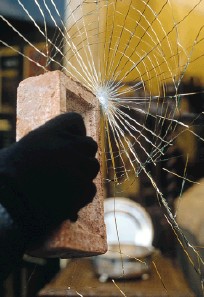Glass and Manual Attack

We categorise glass into safety and security. Safety is where protection is needed from accidental damage and security for wilful damage. Glass used for security reasons can be further broken down into the types of threat:
- Manual attack
- Ballistic attack
- Explosion resistance - See separate section
(There may be security concerns about electronic eavesdropping but in this section we are primarily concerned with the mechanical properties)
For manual attack we would generally suggest laminated glass. Whilst toughened glass is strong it can be broken by the knowledgeable with some ease. Witness the state of bus shelters around the country. The other problem with toughened glass is that once broken it collapses leaving an unprotected hole. Laminated glass can be designed to withstand a varied level of abuse by mixing the glass thickness for strength and the amount of interlayer that binds the glass together to improve penetration resistance. Even when broken laminated glass can still provide protection and slow the would be assailant down. The combination of toughened and laminated glass is often suggested to get the best of both worlds. The reality can be a glass that rapidly loses its integrity when both panes are broken. The lack of support offered by broken toughened can allow the glass to fold and be removed from the frame.
The range of manual attack applications is quite broad. Jewellers windows and screens in vulnerable reception areas are often locations requiring protection above and beyond that offered by impact resistant glass classified by BS6206 or BS EN 12600. The British Standard BS5544 provided a anti bandit solution where glass combined with suitable framing could be said to meet the classification. Note that the glass can not meet this alone and glass supplied for glazing into these situations is stamped to the BS6206 category and not BS5544.
The new European standard gives a broader range of categories but like the BS5544 it does not relate the category to the type of attack. When asked to provide glass that may be subject to a manual attack it is almost impossible to judge the ferocity, dermination, energy and range of implements an unpremeditated attacker might use. The hard body drop tests would cover most applications. The axe test uses glass intended for extreme situations.
European Standards
EN 356 : 1999 : 'Glass in building - Security glazing - Testing and classification of resistance against manual attack'
1. Hard body drop test
2. Axe test
EN 356 : 1999 Classifications
1. Hard body drop test
4.11 kg steel sphere (100 mm diameter)
P1A 3 times from 1.5 m
P2A 3 times from 3 m
P3A 3 times from 6 m
P4A 3 times from 9 m
P5A 9 times from 9 m
2. Axe test
Impact from hammer followed by axe
Minimum no. of strikes to create opening
P6B 30 - 50 strikes
P7B 51 - 70 strikes
P8B over 70 strikes
For many years glass and glass/plastic combinations have been used in bullet resistant screens. Like anti bandit screens the whole structure has to withstand the attack. Multiple layers of glass and interlayer allows the glass to absorb the energy of the projectile and protect the required area. Glass is tested under the worse case conditions and assumes that the assailant aims square to the glass and can group the strikes in a tight pattern. In the design the ability to stop a bullet is easier than controlling the other related issues. The glass when hit is expected to break and flex. The flexing can cause particles of glass to flick off the rear pane. The spall of the back can be designed out but the new standard EN 1063 allows for both ns = no splinters and s = splinters
EN 1063 : 1999 Classifications
BR1 Rifle 0.22 LR
BR2 Hand gun 9mm Luger
BR3 Hand gun 0.357 Magnum
BR4 Hand gun 0.44 Rem Magnum
BR5 Rifle 5.56 x 45
BR6 Rifle 7.62 x 51
BR7 Rifle 7.62 x 51 (different twist length)
SG1 Shot gun Cal. 12/70
SG2 Shot gun Cal. 12/70 (3 strikes)
In cases where personnel sit directly behind the screen the no splinters option is obviously paramount.